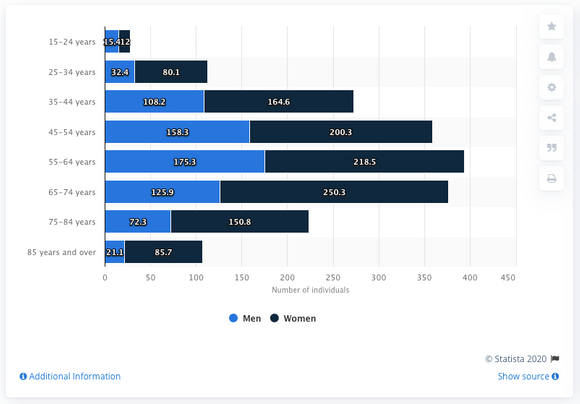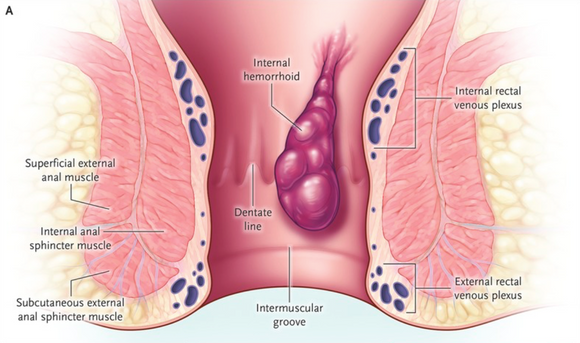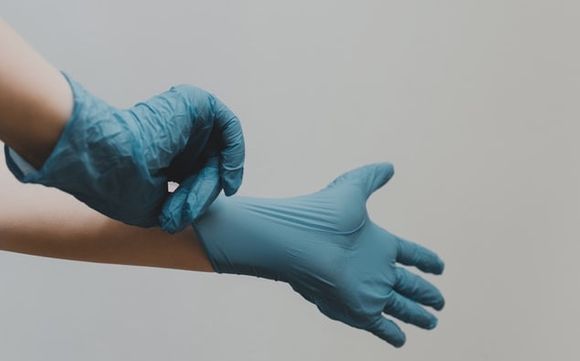Author: Yana Nencheva, Biochemist, PhD candidate in Biophysics
A study in the United States from January 2019 reported that about 1 in 20 people suffer from hemorrhoids. It turns out that this problem manifests itself with advancing age (mostly after 30) and after the age of 50 the frequency reaches 50% [ref. 1].
In another 2017 study in Spain, gender dependence can be clearly seen; namely, that women suffer from this discomfort more often than men. On the diagram in blue are the stronger sex, and in black - the fairer sex, and the numbers are in the thousands. Note that even in the age range 25-34 years, women are about 2.5 times more [ref. 2].

The conclusion of the statistics is that you are not alone. Tension during bowel movements and subsequent hemorrhoids with rectal bleeding are the most common symptoms, and it is quite normal to ask yourself - are they dangerous, whether and when to call a doctor. In this article, we will first consider what hemorrhoids are, and then are they dangerous and when to turn to a specialist.
What are hemorrhoids and what causes them
There are two types of understanding regarding hemorrhoids. The "old school" is of the opinion that they are generally a consequence of weakness of the venous wall, and in recent years the theory is that they are a weakness of the arterial.
Before we go any further, it is important to clarify what the veins and arteries are. Apparently, these are parts of the circulatory system, along with the heart and capillaries. But their structure has several significant differences:
- For this, in their walls, they have a thick layer of smoothmusculature, which, shrinking and expanding, moves the blood through the capillaries to the veins.
- Veins do not need such thick musculature in their walls, with them it is much thinner. Let's imagine them as wide tubes on which the blood should simply be moving in one direction. This structure makes them very susceptible to pressure and, accordingly, deformation.

Let's go back to hemorrhoids. Around the canal (before the anus), besides the sphincters, there are venous braids, which some call even cushions, since they help tightly close the canal [ref. 3]. On the scheme they are invented in blue. As it became clear, the veins have a very thin layer of smooth musculature. This means that they basically rely on the inner musculature to maintain its correct shape and location.
Read more in the article
There are several classic factors that affect the deformation of venous walls:
- Pregnancy exerts pure mechanical tension on the venous vessels in the small pelvis, this is one of the reasons why the percentage of women with this problem is higher,
- Working all over the desk interferes with normal blood circulation,
- Over the years, the inner musculature, which helps maintain the shape of the veins, weakens,
- Over the years, the elasticity of blood vessels in general is also lost, not only on the veins,
- There are people with congenital weakness on the wall of blood vessels, and they often suffer from varicose veins, hernias and others.
If the veins in the duct can not ensure the smooth passage of blood along it, then it quite logically changes its shape: it is no longer the classic tube that we imagined earlier, but begins to bulge grape. In these swollen areas, the wall is thinner, more susceptible to injuries, and when we have constipation, the pressure and tension in the canal rises and injures this venous wall. It is temporarily "cracked" to reduce the tension to which it is subjected and faces the most common hemorrhoidal symptom - rectal bleeding.
Sometimes blood comes out of thrusts, and since the arteries are the vessels with the thick layer of smooth musculature, the contraction and expansion of which can cause the ejection, then this is the basis of the theory that hemorrhoids are a consequence of arterial problems.
As varieties in general, hemorrhoids are divided into three types:
- Internal
- External
- Mixed
Internal ones remain in the canal, and the outer ones are usually closer to the anus, so they actually go outside from it and sag. Some even define them only as internal because of their origin, which is objectively internal. Mixed are in the presence of both species.
Read more:
Indigestion (dyspepsia) - causes, symptoms and treatment
7 herbs that relieve indigestion and dyspepsia
Are hemorrhoids dangerous and when to call a doctor

First it can be on the face itching, tension and pain in the area of the coccyx, and then it can switch to bleeding. The organism has this "weak spot" because it can afford it. Very quickly after the blood leaks begins to form a fortifying network of connective tissue, which makes the place more rigid, firmer. Hardness in this case does not necessarily mean strength. If an object is firmer, this is usually accompanied by a loss of elasticity and "fragility". However, this network in this case strengthens the place and the problem resolves itself. That's how the so-called "no-fly zone" is shaping up. which describes the hemorrhoid. For this, and people with chronic hemorrhoids know that when there is bleeding, then the hemorrhoidal crisis goes to a lute.
Hemorrhoids are not dangerous in almost all cases. If bleeding is unusual and prolonged, then there is a danger of complication such as. Anemia. But what does "unusual" and "prolonged" mean?
Usually, the blood from hemorrhoids is clear, red, punctated, it can be seen on the stool in this color, on toilet paper when wiping, and then on the underwear or bandage. Normally, the blood comes out of the push and leaks, and within 5 minutes it should stop.
If the bleeding is clots, it is not punctual, but in a larger amount, there is an ominous smell and impurities with mucus, does not stop more than 5 minutes from flowing, with the 5 minutes counted from the corresponding bleeding, then we should consult a doctor.
Doctors advise - if you call them urgently, have visual material (napkin, stool, underwear, bandage) to show the consistency that bothered you [ref. 4].
Read more:
How to recognize the ulcer of the stomach - causes, symptoms and treatment
The intestinal microbiome is extremely important to us and our baby
Gastritis - symptoms and treatment









